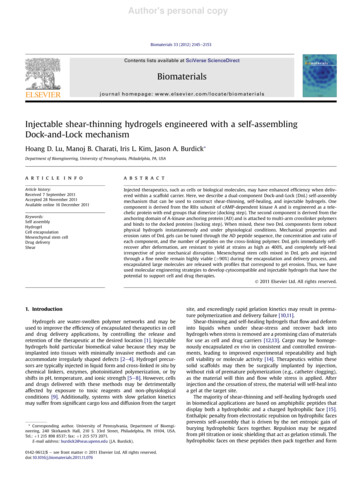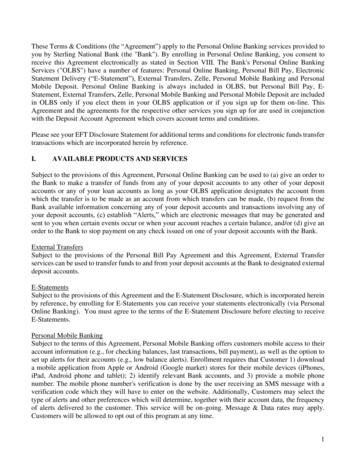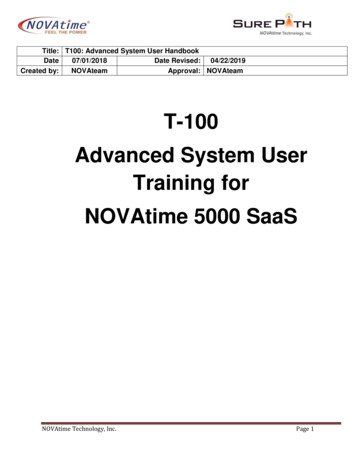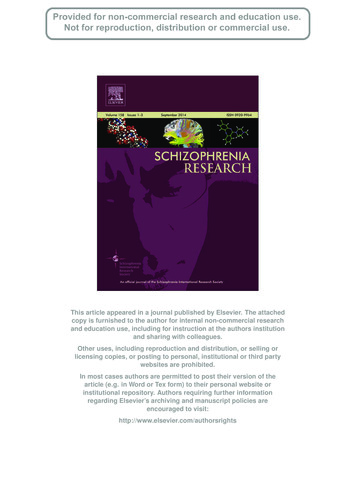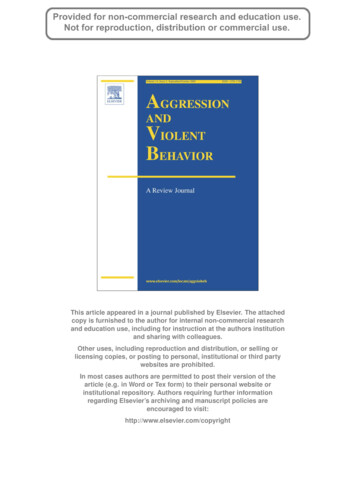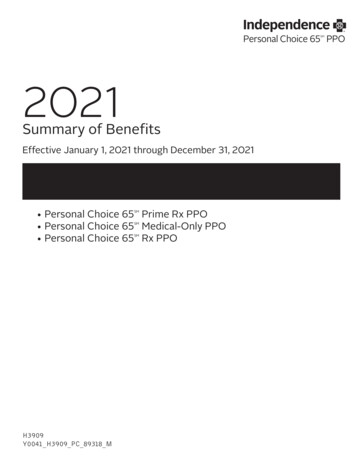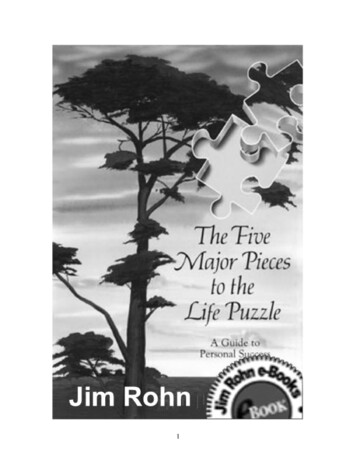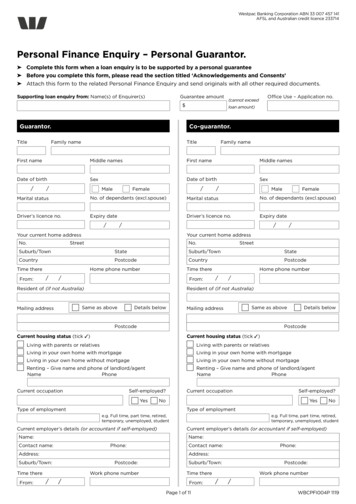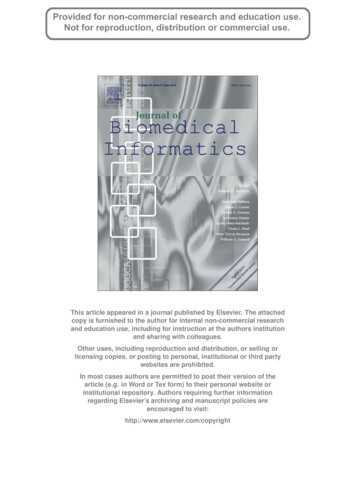
Transcription
This article appeared in a journal published by Elsevier. The attachedcopy is furnished to the author for internal non-commercial researchand education use, including for instruction at the authors institutionand sharing with colleagues.Other uses, including reproduction and distribution, or selling orlicensing copies, or posting to personal, institutional or third partywebsites are prohibited.In most cases authors are permitted to post their version of thearticle (e.g. in Word or Tex form) to their personal website orinstitutional repository. Authors requiring further informationregarding Elsevier’s archiving and manuscript policies areencouraged to visit:http://www.elsevier.com/copyright
Author's personal copyJournal of Biomedical Informatics 43 (2010) 435–441Contents lists available at ScienceDirectJournal of Biomedical Informaticsjournal homepage: www.elsevier.com/locate/yjbinTMA-TAB: A spreadsheet-based document for exchange of tissue microarraydata based on the tissue microarray-object modelYoung Soo Song a, Hye Won Lee b, Yu Rang Park a, Do Kyoon Kim a, Jaehyun Sim a, Hyunseok Peter Kang c,Ju Han Kim a,d,*aSeoul National University Biomedical Informatics (SNUBI), Seoul National University College of Medicine, Seoul 110-799, Republic of KoreaDept. of Molecular Genetics and Microbiology, College of Medicine, University of Florida, FL, USADept. of Pathology and Laboratory Medicine, Roswell Park Cancer Institute, Buffalo, NY, USAdDivision of Biomedical Informatics, Seoul National University College of Medicine, Seoul 110-799, Republic of Koreabca r t i c l ei n f oArticle history:Received 10 June 2009Available online 14 October 2009Keywords:DatabaseMicroarray dataModelingTissue microarraya b s t r a c tThe importance of tissue microarrays (TMA) as clinical validation tools for cDNA microarray results isincreasing, whereas researchers are still suffering from TMA data management issues. After we developeda comprehensive data model for TMA data storage, exchange and analysis, TMA-OM, we focused ourattention on the development of a user-friendly exchange format with high expressivity in order to promote data communication of TMA results and TMA-OM supportive database applications. We developedTMA-TAB, a spreadsheet-based data format for TMA data submission to the TMA-OM supportive TMAdatabase system. TMA-TAB was developed by simplifying, modifying and reorganizing classes, attributesand templates of TMA-OM into five entities: experiment, block, slide, core in block, and core in slide.Five tab-delimited formats (investigation design format, block description format, slide description format, core clinicohistopathological data format, and core result data format) were made, each representingthe entities of experiment, block, slide, core in block, and core in slide. We implemented TMA-TABimport and export modules on Xperanto-TMA, a TMA-OM supportive database application, to facilitatedata submission. Development and implementation of TMA-TAB and TMA-OM provide a strong infrastructure for powerful and user-friendly TMA data management.Ó 2009 Elsevier Inc. All rights reserved.1. IntroductionTissue microarrays (TMA) are a promising array-based technology in cancer research and their importance in pathology isincreasing due to their role in the clinical validation of cDNAmicroarrays [1]. TMA technology allows researchers to examinethe expression of protein, DNA or RNA on hundreds or thousandsof tissue samples while preserving morphology [2]. This increasedthroughput accelerates the discovery of important biologic markers compared to traditional marker studies using whole slide sections and has made this technology an essential tool in humanprotein profiling [3].There is an enormous amount of data, including clinical and histopathological information associated with the cores in TMA blocks.This data grows exponentially even with a single experiment,which generates interpretation results for each core on a slide.* Corresponding author. Address: Division of Biomedical Informatics, SeoulNational University College of Medicine, 28 Yongon-dong Chongno-gu, Seoul 110799, Republic of Korea. Fax: 82 2 742 5947.E-mail address: juhan@snu.ac.kr (J.H. Kim).1532-0464/ - see front matter Ó 2009 Elsevier Inc. All rights reserved.doi:10.1016/j.jbi.2009.10.001Without powerful data management tools, the incredible volumeof TMA data can be a burden to researchers, resulting in improperinterpretation of data. For example, if data about the interpretationof the cores is recorded in one repository and data about the clinicaland histopathological findings in another and there is no availableinformatics tool to integrate these data, one may try to do this manually, increasing chances of misinterpretation, especially withoutproper identifier and vocabulary management. Many TMAresearchers typically work in laboratories without bioinformaticssupport and have difficulties managing TMA data.In biomedical research, the development of standards, such asminimum information specification, data exchange format, and object model are essential to provide a solid basis for the development of data management applications. In the fields of cDNAmicroarray and proteomics, these efforts have been made by theMicroarray Gene Expression Data (MGED) group and the HumanProteome Organization (HUPO), respectively (Table 1) [4–8]. Thesestandards are successfully implemented and widely used, the typical examples being ArrayExpress in cDNA microarray and PEDRoin proteomics. Along with these trends, standards have also beenproposed for TMAs.
Author's personal copy436Y.S. Song et al. / Journal of Biomedical Informatics 43 (2010) 435–441Table 1Comparison between development of data standards in biomedical research.Data standardscDNA microarray dataProteomics dataTMA dataMinimum information specificationData modelXML format for data exchangeSpreadsheet format for data rrayExpressMAIPEPSI-OMPSI-MLPRIDE proteomics harvest spreadsheetPEDRoTMA DESTMA-OMTMA DESNot availableXperanto-TMAMIAME: minimal information about microarray experiment, MAGE-OM: microarray gene expression object model, MAGE-ML: microarray gene expression markup language,MAGE-TAB: microarray gene expression tabular, MAIPE: minimum information about a proteomics experiment, PSI-OM: proteomics standards initiative object model, PSIML: proteomics standards initiative markup language, PRIDE: proteomics identifications database, PEDRo: proteome experimental data repository, TMA DES: tissuemicroarray data exchange specification, TMA-OM: tissue microarray-object model.The Association of Pathology Informatics proposed an open access TMA data exchange specification (TMA DES) as a format forsharing TMA data in 2003 [9]. TMA DES is a well-made XML document with a suitable structure that contains essential data elements of TMAs, such as experiment, block, slide and core in ahierarchical design and is very useful in the management of TMAdata.Our group proposed TMA-OM as a data model with integrity,flexibility and extensibility in dealing with TMA data [10]. TMAOM provides a comprehensive model for storage, analysis and exchange of TMA data and also facilitates model-level integrationwith other biological models. During the development of TMAOM, every kind of data and event that a TMA experiment can produce was thoroughly analyzed, including experiment design, blockdesign, acquisition of clinical and histopathological data, blockconstruction, slide cutting, staining, image acquisition, image analysis and management of the whole system. TMA-OM, having multidimensional features, can provide data necessary not only forresearchers but also for technicians, block manufacturers, antibodyproducing companies and developers of TMA database systems. Asthe first application based on TMA-OM, a web-based databasemanagement system, Xperanto-TMA (available at http://xperanto.snubi.org/tma/) was implemented.The TMA-OM supportive database has been suffered from thecomplexity of data models, long list of required elements, andlow level of user-friendliness for the non-informatician pathologists. Instead of improving the user interface, we concluded thatwe needed a simpler, ease-to-understand representation of TMAdata reflecting the perspective of a typical TMA researcher.To overcome the limitations of TMA-OM, we designed a spreadsheet-based data exchange format for TMA data. There were threerationales for the development of a spreadsheet-based format.First, we tried to address the drawbacks of the TMA DES, whichdoes not provide detailed instructions for clinical and histopathological data, with data structure of each document being dependenton the author, which creates the possibility that results of identicalexperiments might have different data structures. Moreover, because TMA DES is based on XML, it is not available to mostresearchers working in laboratories without bioinformatics support. Second, the multidimensional nature of TMA-OM is not suitable as a data exchange format and needs to be simplified for TMAdata exchange. We created a new model for TMA data exchange byselecting and reorganizing the data elements in TMA-OM. The dataexchange format based on this model should provide sufficientclinical and histopathological information to the level of granularity required for most TMA research. Third, spreadsheets are a useful data exchange format in biomedical research whenexperimental design is regular or simple. From our experience,most TMA research projects have a simple experimental designand a set of designs can be defined that encompass most projects.Moreover, spreadsheets are a very familiar format to mostresearchers and much TMA data is already stored in this format.This is not unique to TMAs. Spreadsheet-based data exchange for-mats including MAGE-TAB, PRIDE Proteomics Harvest Spreadsheet,and ISA-TAB, were developed for cDNA microarray, proteomics andcombinations of omics-based experiments, respectively [11–13].The spreadsheet format has also been used for partial uploadingof TMA data in other TMA database systems [14,15]. The usefulnessof a general format compared to a specific interface is that it givesmore freedom to both researchers and developers without beinglimited to specific platforms.In this article we propose TMA-TAB as a spreadsheet-based dataexchange format for TMA data. TMA-TAB can be used for data collection, presentation, and communication between researchers ormachines. It is easy-to-learn without any knowledge about bioinformatics. We also implemented an import and export interfacesto the TMA-OM supported web application, Xperanto-TMA. We expect that this will accelerate TMA workflow, promoting TMA research as a whole.2. Methods2.1. Conceptual schemaThe first step in designing a simple and easy-to-learn format fordata exchange was to determine the data elements of TMA experiments that are of concern to researchers. Most researchers areinterested in how results of immunohistochemical assays correlatewith the clinical and histopathological data annotations of eachcore section on a slide.Next, we had to generalize those data elements into several representative entities. Experiment, block, slide, core in block andcore in slide were chosen as five entities representing essentialTMA data. Core in block and core in slide play a role in annotating clinical and histopathological data and interpreting results.Block and slide connect these two entities and experiment encompasses all of these entities. These five entities were partially implemented by the TMA DES although it did not divide core intocore in block and core in slide [9]. Using these five entities, mostof the concepts in TMA data important to researchers can be successfully described (Table 2). One of the advantages of introducingthese entities is that these are very familiar concepts to researchers, hence enabling easy understanding of the structure and relationships of the entities.We then generated attributes for each entity, which explain anddescribe the characteristics of each entity. Attributes were drawnfrom the classes, attributes and templates of TMA-OM, and thesewere reorganized, simplified and modified based on the needs ofresearchers. This process occurred in four steps. First, only classescontaining real TMA data were selected while classes representingprocesses or events were excluded.Second, the remaining classes were clustered into five entitiesand related classes were combined to produce new attributes ifthis process did not cause severe information loss. For example,the TMA-OM’s TumorInfo class in the HisoPathol package having
Author's personal copy437Y.S. Song et al. / Journal of Biomedical Informatics 43 (2010) 435–441Table 2Overall features of TMA-TAB and its relationship with TMA-OM.Entities inTMA-TABData formatin TMA-TABData contentsPackages in TMA-OM (percentage of classesrepresented by TMA-TAB among totalclasses of each package)ExperimentBlockIDFBDFExperiment (100%)Block (25%), BlockDesign (100%)SlideSDFCore in blockCCDFTitle, ExpType, ExpFactor, Description, ExternalLinkBlockIdentifier, NumOfRow, NumOfCol, CoreSize, BlockConstructionProtocol,BlockCreationDate, Description, ExternalLinkSlideIdentifier, SlideStain, SlideTestCategory, SlideSerialNumber, SlideProtocol,SlideCutDate, SlideStainDate, BlockIdentifier, Description, ExternalLink43 templates dependent on tissue and cancer typesCore in slideCRDFAbsentProtocolformatAvailability, PercentOfTissueStaining, TissueIntensity, NumberOfNucleiCounted,EvaluationCategory, StainingCompartment, StainingPattern, CoreType,InterpretationProtocol, Description, SlideIdentifier, PosRow and PosColProName, ProType, DescriptionArray (67%), BioAssay (9%), Reporter (25%)DesignElement (33%), BioMaterial (43%),HistoPathol (100%), ClinInfo (56%)BioAssayData (6%), QuantitationType (71%)Protocol (10%)IDF: investigation description format, BDF: block description format, SDF: slide description format, CCDF: core clinicohistopathologic data format, CRDF: core result dataformat.classes, Tstage, Nstage, Mstage, BasicHistoPathol, NstageInfo, TstageInfo, MstageInfo, TNMstage, pathologist reviewed and tumorStageCodeType, can be modified and simplified as attributes ofTstage, Mstage, Nstage and pathologists in the core in block entitythrough unification of associated classes. Every class of the TMAOM was investigated in this way.Third, each attribute was evaluated as to whether the data itrepresented was really practical in the TMA experiment. As a resultof this process, 53% of classes and 64% of attributes in the TMA-OMare represented by TMA-TAB. Excluded classes represent an eventsor a processes and excluded attributes describe technical details,most likely beyond the interest of researchers.Fourth, 43 premade templates in TMA-OM for describing organspecific specimen information were restructured into sets of categories and values and the categories were added to the attributesof core in block. For example, a template in TMA-OM for gastrointestinal lymphoma consists of three common data element (CDE)groups (Macroscopic, Microscopic, Histologic), 12 categories underthe CDE groups (HistologicType NonHodgkinLymphoma, HistologicType B-cellLymphoma, HistologicType T-cellLymphoma, etc.),and 75 values under the categories (B-cellLymphoma, T-cellLymphoma, Hairy cell leukemia, etc.). The template is restructured byremoving the CDEs, CDE groups, and the hierarchical structuresof the categories and subcategories. The categories, HistologicType B-cellLymphoma and HistologicType T-cellLymphoma, forexample, are subcategories of HistologicType NonHodgkinLymphoma. Because hierarchical information is hard to apply toTMA-TAB and the permissible values for HistologicType B-cellLymphoma and HistologicType T-cellLymphoma are mutuallyexclusive with each other and exhaustive to the super-category,HistologicType NonHodgkinLymphoma, these two subcategoriescan be unified and merged into HistologicType NonHodgkinLymphoma without information loss. Each step involves no information loss because the permissible values in the pathologicdiagnosis of a sample for HistologicType B-cellLymphoma and HistologicType T-cellLymphoma are mutually exclusive and exhaustive to HistologicType NonHodgkinLymphoma. Then eachrestructured category was entered as an attribute into the entityof core in block. The values of each category are used for determining the permissible values of each cell (see Section 2.3).After generation of attributes, we defined rules of relationshipbetween the entities, listed below.1. An instance of a block is owned by one or more instances ofexperiments.2. An instance of a slide originates from an instance of a block.3. An instance of a core in block is owned by an instance of a block.4. An instance of a core in slide originates from an instance of acore in block and also owned by an instance of a slide.If two entities are related, each entity should have attributesboth for identifying self and for referring to the other entity thatit owns or originates from. In this way, entities can refer to eachother. Referring data from an instance of core in slide to an instance of core in block is a reflection of a real world event ofTMA data processing where researchers analyzing a core in aTMA slide find the corresponding clinical and histopathologic dataannotated to a core with the same coordinates in the source block.2.2. Formalization of TMA-TAB from conceptual schemaWe created five tab-delimited files from the premade conceptual schema that preserved their structure. These are investigationdescription format (IDF) from the experiment in the conceptualschema, block description format (BDF) from the block, slidedescription format (SDF) from the slide, core clinicohistopathologicdata format (CCDF) from the core in block and core result data format (CRDF) from the core in slide (Table 2).Headers in the first row correspond to the attributes in the conceptual schema. TMA data is inserted into the cells under the headers. Each row of data corresponds to one instance of an entity.In the case of CCDF, it was not reasonable to use all the attributes taken from the conceptual schema because important clinical and histopathologic data vary depending on the tissueexamined and the type of cancer. We created, therefore, 43 typesof CCDF templates for 43 cancers according to the College of American Pathologists (CAP) Cancer Protocols and checklists so thatresearchers can select a template best describing the experiment.Besides these five formats, attributes describing protocols orprocedures in conceptual schema were organized separately intoprotocol formats. These are block construction protocol, slide protocol, pretreatment protocol for antibody or probe, fixation protocol, surgical procedures, and slide reading protocol. Though thesame information can be provided regardless of whether dataabout protocols or procedures are stored independently (protocolformats) or in association with IDF, BDF, SDF, CCDF or CRDF, thisreduces the potential redundancy of TMA-TAB.2.3. OntologyVocabularies used in TMA-TAB are taken from MGED Ontology,TMA DES, terms from MISFISHIE, CDEs of CAP Cancer Protocols andNCI CDEs [9,16,17] as in TMA-OM [10]. Permissible values of eachcell were determined by the header and are specified in the docu-
Author's personal copy438Y.S. Song et al. / Journal of Biomedical Informatics 43 (2010) 435–441ment of specifications on TMA-TAB [18]. In brief, the values wereselected to be made both convenient to use and compatible withthat of implemented TMA-OM. If the header corresponded to a category of a template in TMA-OM, the values under the category inthe template were used for the permissible values of the cell underthe header, slightly modified for convenience if necessary.2.4. ApplicationFinally we implemented TMA-TAB on Xperanto-TMA, a webbased TMA database application using TMA-OM, allowingresearchers to submit TMA data by simply uploading TMA-TABfiles.3. Results3.1. Structure of TMA-TABTMA-TAB consists of five tab-delimited files (IDF, BDF, SDF,CCDF and CRDF) and additional protocol files (Table 2). Accordingto definitions from the RSBI working group, ‘investigation’ is aself-contained unit of scientific inquiry with a holistic hypothesisor objective and ‘assay’ is a part using particular technologies[19]. TMA-TAB can contain data on only one investigation, butmore than one assay can be included under one investigation.Each file in TMA-TAB has headers in the first row and TMA datacan be inserted starting from the second row (Fig. 1). For the submission of TMA-TAB into a TMA database, the relationship withpreexisting data should be considered. For example in XperantoTMA, if the value of the ‘Title’ column in IDF is ‘MTA-1 expressionin colon cancer’ and another experiment with the same title hasbeen already registered in the database, users are prevented fromsubmitting the TMA data under the same title. Users should checkif the data to be submitted is already stored in the TMA system. Ifthe files represent a different experiment the Title attribute shouldbe changed. With this policy, each experiment in TMA databasesystem has a unique title, preserving data integrity.The following is a brief description of each format. For more detailed information and examples of TMA-TAB, please refer to thedocument of specifications (Suppl TMA TAB Specification.htm,Suppl example colorectal.xls and Suppl UML.htm, available athttp://xperanto.snubi.org/TMA/suppl/).3.1.1. Investigation description format (IDF)IDF describes the overall outline of an experiment includingexperimental factor, design and type. Because TMA-TAB can include only one instance of a TMA experiment, IDF has only twoFig. 1. Example of TMA-TAB usage with an ovarian cancer template.
Author's personal copy439Y.S. Song et al. / Journal of Biomedical Informatics 43 (2010) 435–441rows, headers in the first row and data in the second row. Theheaders are Title, ExpType, ExpFactor, Description, and ExternalLink. No additional headers are permitted. Controlled vocabulariesand ontologies including the MGED Ontology, TMA DES, termsfrom MISFISHIE, CDEs of CAP Cancer Protocols and NCI CDEs areapplied for the values of ExpType and ExpFactor. Any string canbe applied to describe the Title, Description and ExternalLink, except that the values of Title should be unique among the experiments stored in a system for the purpose of eliminating conflicts.All permissible values for each cell in the TMA-TAB format are described in the specification file (http://xperanto.snubi.org/tma/Suppl/Suppl TMA TAB Specification.htm).3.1.2. Block description format (BDF)BDF contains overall information about blocks such as name,numbers of rows and columns, and core size. For the submissionof TMA-TAB to TMA database system, the value of BlockIdentifiershould be unique: and data with a block identifier that exists inthe database cannot be resubmitted. Unlike TMA-OM, the unit ofCoreSize is already determined as mm.3.1.3. Slide description format (SDF)SDF describes the general information of each slide, such asslide name, stain and slide test category. For the submission ofTMA-TAB, SlideIdentifier should be unique under a single experiment. This means if slides belong to different experiments, thesame SlideIdentifier is allowed. The value of SlideStain is the nameof the antibody, probe or lectin. For submission, the staining material should be registered first, providing information about the target molecule, type of staining, staining compartment and reporterprovider. BlockIdentifier of SDF refers to the name of the block theslide originates from: information on the block may already existin the database or be submitted at the same time.3.1.4. Core clinicohistopathologic data format (CCDF)CCDF contains information on tissue cores and annotated clinical and histopathological information. Unlike other formats, CCDFhas 43 templates depending on the tissue and type of cancer anduser-defined data elements can be added to any existing templates.For example, a template for colorectal cancer has 38 headers,including BlockIdentifier, PosRow, PosCol, SpecimenId, Fixation,FixationProtocol, Sex, Age, Histology, HistologicGrade and TumorSize. Although there is no single column for the identifier of thecore, the combination of BlockIdentifier, PosRow (position ofrow), and PosCol (position of column) fulfills this role. The unitof TumorSize is designated as cm.When describing microscopic configuration of a tumor, ‘infiltrating’ and ‘invasive’ can refer to similar characteristics, but inTMA-TAB, ‘infiltrating’ is a permissible value while ‘invasive’ isnot permissible in the MicroscopicConfiguration data element. Thisallows clear description of TMA data that both humans and machines can understand. Table 3 shows an example of a CCDF ofcolorectal cancer (Due to the limitation of space, only part of theCCDF is shown. An example with the entire CCDF is provided inthe Supplementary material) [18].3.1.5. Core result data format (CRDF)CRDF contains experimental data on the cores of TMA slides.Headers include Availability, PercentOfTissueStaining, TissueIntensity, NumberOfNucleiCounted, EvaluationCategory, StainingCompartment, StainingPattern, CoreType, InterpretationProtocol,Description, SlideIdentifier, PoswRow and PosCol. The combinationof SlideIdentifier, PosRow, and PosCol serve as a unique identifier.3.2. Implementation of TMA-OM and TMA-TAB as Xperanto-TMAXperanto-TMA is a web-based application using MySQL 4.1 andbased on TMA-OM [20]. The relational schema is derived fromTMA-OM by object-relational mapping. The experiment-friendlyinterface of Xperanto-TMA was designed with the general workflow of a TMA experiment in mind. Xperanto-TMA accommodatesa controlled vocabulary and a template-driven data managementsystem providing design and registry functionalities. Since Xperanto-TMA was implemented in 2006, several functions have beenadded to the initial system: the complete list of features is described below.3.2.1. Data submissionThe data submission function aims to provide an accuraterecording tool by adopting aspects of structured data entry suchas controlled vocabularies and pre-defined data elements. Xperanto-TMA provides two ways of data submission: (1) editing onlinesubmission forms for experiment, slide, block and core data and(2) uploading TMA-TAB files.When submitting data by editing online submission forms,users should enter information about experiment, block and slidebefore the submission of data on core in block or core in slide.Users can insert TMA data either by typing or by choosing one ofitems from the selection box to use the controlled vocabulary.If users submit data by uploading TMA-TAB, they can selectfrom five scenarios. These scenarios are developed for the user’sconvenience for situations when the whole set of experiments isnot completed and only part of the data is available but users wantto upload the data that they have. For example, when TMA blocksand annotated clinical and histopathologic data have been prepared but the slides have not been stained yet, users can uploadBDF and CCDF by selecting the fifth scenario. After uploading, thesystem automatically validates formats, data relevance, and relationship between each format, preventing incorrect or discrepantTable 3An example of a part of a CCDF for colorectal cancer.BlockIdentifierPosRow PosCol SpecimenIdSex Age DiagnosisDate OperationNameHistologyTumorSiteTumorSizeColon Array73Colon Arrray73Colon Arrray73Colon Arrray73Colon Arrray73Colon Arrray73Colon Arrray74Colon Arrray74Colon Arrray74Colon Arrray741112221122FMMMMMFMMMAdenocarcinoma tumSigmoid colonSigmoid colonRectumRectumDescending colonRectumDescending l resectionAbdominoperineal resectionAbdominoperineal l resectionAbdominoperineal resectionLeft hemicolectomyAbdominoperineal resectionLeft hemicolectomyaIf multiple values are allowed in a cell, use ‘ ’ as a delimiter. To find the fields where multiple values, refer to the document of specification in the Supplementary material(http://xperanto.snubi.org/TMA/suppl/Suppl TMA TAB Specification.htm).
Author's personal copy440Y.S. Song et al. / Journal of Biomedical Informatics 43 (2010) 435–441values from being submitted to the system. During the submissionof TMA-TAB, one can also describe user-defined terms.3.2.2. Data export: text and XMLUsers can export the data for each experiment as well as tissueinformation into tab-delimited text and XML files conforming tothe TMA DES. The exported file contains all information aboutthe experiment including array, clinical and histopathologicalinformation.3.2.3. Controlled vocabularyXperanto-TMA utilizes controlled vocabularies including MGEDOntology [17], 80 tags of TMA DES, terms from MISFISHIE for TMAexperiment procedures, and CDEs extracted from CAP Cancer Protocols and NCI CDEs for clinical and histopathologic information.CDEs for clinical and histopathologic information are under thecontrol of a system administrator but user-defined CDEs can beadded with sysadmin approval. Allowing user-defined CDEs mayeventually require a central ‘standard’ repository of CDEs that arewidely accepted by the TMA data management community. Inthe mean time, collaborators can run regional CDE repositorieswith administrative control and communicate periodically.3.2.4. Template managementThe template is a form composed of common data elements(CDEs) which are metadata to describe data. Researchers can usepre-defined t
to the TMA-OM supported web application, Xperanto-TMA. We ex-pect that this will accelerate TMA work ow, promoting TMA re-search as a whole. 2. Methods 2.1. Conceptual schema The rst step in designing a simple and easy-to-learn format for data exchange was to determine the data elements of TMA exper-iments that are of concern to researchers.
